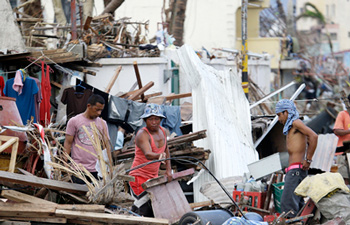

Vol. 77/No. 43 December 2, 2013

|
| AP/Bullit Marquez |
| Working people were left to fend for themselves in areas hardest hit by powerful Typhoon Haiyan where they lived in housing incapable of withstanding recurring storms. Many now lack necessities of food, water, medicine and shelter. Above, Tacloban, Philippines, Nov. 17. |
The catastrophe was prepared by the market relations on the land that determine that a growing multitude of workers, farmers and fishermen live in “affordable” low-lying flood-prone regions — more than 60 percent of the country’s population lives in the coastal zone. And the same social relations ensure that rather than living in homes constructed for the inevitable storms, these working people reside in the most flimsy housing. Even the schools and other buildings designated as disaster shelters were too shoddy to offer sufficient protection.
According to Philippine government figures as of Nov. 17 nearly 4,000 people died, 1,186 are missing and more than 12,000 injured during the storm and its aftermath.
According to the U.N. Office for Coordination of Humanitarian Affairs, 2.5 million people need food assistance, but only 375,000 have gotten any help; 248,176 homes were destroyed and 246,435 damaged; and nearly 2 million are homeless.
Ten days after the typhoon, bodies still littered the streets in Tacloban, the center of the relief effort.
Philippine Interior Secretary Max Roxas told reporters that Tacloban, on Leyte Island, had only eight working trucks. Tons of food, water and medicine have piled up, but without transport or organization, much has yet to be distributed. The national government declared martial law there, imposing an 8 p.m. to 5 a.m. curfew and sending some 2,000 police and soldiers, whose primary function is protection of property.
Tim Shenk, press officer for Doctors Without Borders, told the Militant from New York Nov. 19 that the 160 personnel the organization has sent to the disaster areas are “not close to meeting the needs.” He called it “a logistical nightmare,” adding “many roads remain blocked and damaged, and fuel and vehicles are in short supply.”
The group’s emergency coordinator, Natasha Reyes, reported the same day that their medical teams are worried that the lack of clean water and adequate shelter could cause an outbreak of deadly diseases such as typhoid, cholera, and leptospirosis.
No evacuation organized
The government was aware of the impending typhoon days in advance. “This one will be dangerous,” the Puerto Galera Yacht Club in the Philippines said in a message it sent out based on information from the Joint Typhoon Warning Center almost four days before the storm hit. “Be warned!”But it wasn’t until two days later that the government says it began to broadcast warnings and told people they should leave danger zones, without offering any means to transport families and their belongings or anywhere safe to go.
“Some of the people went to the school because it was supposed to be a safe place,” schoolteacher Cirila Codilla told the Militant by phone from Ormoc City on Leyte Island’s west side Nov. 18. “But much of it was destroyed. Now there are people living in the portions of the school that were not destroyed.”
“The wind took away the roof of our home. We don’t have light, we don’t have water, sometimes we don’t have food to eat,” she said. Her family charges up their cellphone at a generator at a bakery.
“Sometimes they have given us rice, but they only give us one or two kilos for the whole family, it’s not enough.”
Washington and other imperialist powers have been dispensing aid with an eyedropper. The U.S. aircraft carrier George Washington, with a crew of 5,000 and 80 aircraft, arrived off the coast of Tacloban Nov. 14, six days after the storm hit. Washington has pledged a mere $20 million in aid so far. The United Kingdom has pledged $32 million.
Meanwhile, the foreign debt of the Philippines topped $60 billion last year, and there is no suggestion to forgive one penny. A quarter of the population lives hand to mouth on less than $1.25 a day, allowing no reserves to get by following a major disaster.
The Los Angeles Times reported Nov. 15 that relatives have been lining up in Cebu every day to get ferry tickets to take them to Ormoc with supplies for the disaster zone. The paper interviewed bank worker Dimples Juntilla who brought supplies to Ormoc earlier in the week and was heading back with more.
“I don’t want to blame the government, but it is so disheartening that it took our president five days to get relief to us,” she said. “They say it is difficult to travel, but why are we able to and they are not?”
Front page (for this issue) |
Home |
Text-version home